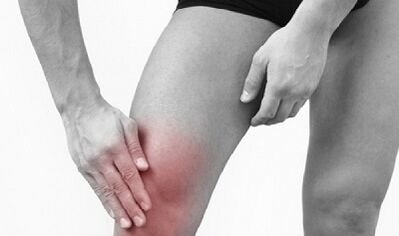
One of the most common pathologies of the muscle bone system is the arthrosis of the knee joint (otherwise gonarthrosis), a chronic disease accompanied by dystrophy and destroying the joint structure of the knee.
The result of destructive processes is a sharp restriction or complete loss of joint mobility, and as a result - performance, a reduction in disability.
The harmful consequences can only be prevented if the therapy is diagnosed and treated in time.
Reasons
According to the origin, the knee arthrosis is primary and secondary.As a primary disease, it develops as a primary disease, is more often diagnosed in older people, and in this case the consequences of changes related to the age in tissues.Secondary gonarthosis is as a result of other diseases and disorders of the body.
The formation of gonarthrosis contributes to:
- injuries (dislocations, fractures, meniscus damage);
- Muscle bone disease (congenital deformation of the legs, knee dysplasia, chondrocalcinosis, arthritis, osteoporosis);
- Professional activities and professional sports are constant heavy loads in the joint;
- overweight, obesity;
- endocrine diseases, including diabetes, hypothyroidism, acromigaly;
- metabolic disorders;
- Genetic predisposition.
Symptoms
Inflammation of the arthrosis of the knee joint is accompanied by two main clinical manifestations - pain and edema.The intensity and frequency of the appearance of pain depends on the depth of damage to the joint structures.In the initial stages, the pain can only be felt with load and is quickly resting.In advanced gonarthrosis, pain is constantly increased during pain and movements by changing weather conditions.
Other signs of arthrosis of the knee joint:
- Crunch when moving;
- stiffness in the joint, violation of motor function;
- Deformation of the knee (neglected gonarthrosis).
Gonarthrosis synovitis (accumulation of fluid in the joint cavity) and subsequent Baker cyst formation (elastic formation on the back of the knee).
Articular
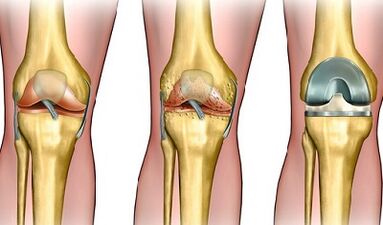
Symptoms of the arthrosis of the knee joint differ depending on the depth of damage to the structure of the knee, and therefore 3 sections of the pathology can be distinguished.
- The knee joint is 1 degree joint jointThis is illustrated by the poor pain of the loads (at the same time at the same time), with mild stiffness after sleep.In the radiographic image, insignificant narrowing of the joint gap (less than one third), the presence of the only osteophytes (bones outgrowth) should be observed.
- The knee joint is 2 degrees of joint jointMovements are accompanied by pain and characteristic crisis.The pain persists for a while during rest.We observe morning stiffness, restricting the amplitude of movements.Diagnostic procedures reveal a priority narrowing of the joint gap (more than half) and more osteophytes.
- The knee is 3 degrees of joint jointThis is accompanied by constant painful pain, which increases during movement and at night.Breakfast stiffness remains longer than an hour, worsening of the inflammation and at least half an hour during the remission period.The joint mobility is sharply limited or completely lost.The radiographic picture shows several large osteophytes and cysts.The joint gap is narrowed by more than two norms.
Depending on the degree of arthrosis of the knee joint, the patient prescribes conservative or surgical treatment.
Diagnosis
Diagnosis of the arthrosis of the knee joint includes visual examination, patient's complaint analysis, laboratory tests (urine analysis, general and biochemical blood test) and instrumental test methods.
The following diagnostic procedures allow you to confirm or refute your diagnosis:
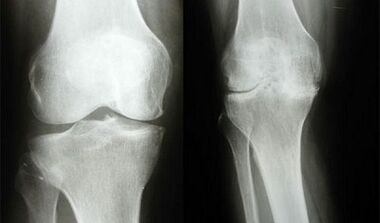
- radiography;
- Ultrasound (ultrasound);
- MRI (magnetic resonance imaging);
- CT (computer tomography);
- Arthroscopy and scintigraphy (suspicion of tumor).
Using these methods, narrowing of the joint gap, narrowing of thinning and cartilage deformation, presence of fluid in the joint cavity, structural changes in the synovial membrane, increase in osteophyte and cartilage.
Conservative treatment
Conservative treatment methods can reduce pain and inflammation, improve blood circulation and periastate tissue nutrition, and strengthen muscle device.
They are kept for this purpose:
- medication;
- blockade;
- physiotherapy and manual therapy;
- Medical physical education.
An important component of the treatment of arthrosis is to observe therapeutic diet.
Conservative treatment of the arthrosis of the knee joint will be effective at the initial stage of the disease when smaller dystrophic cartridges of cartilage, inflammation and synovial peel are observed.
Drugs
Drug treatment includes the appointment:
- non -steroid anti -inflammatory drugs (NSAID);
- chondroprotectors;
- hyaluronic acid.
Nsaid
Non -sertoid anti -inflammatory drugs help relieve inflammation, reduce its main symptoms -edema and pain.
The preparations are prescribed in the form of solutions (for intramuscular administration) or tablets, capsules (for oral administration).Capsules and tablets from arthrosis of the NSAID group are taken into account in short courses because the drugs have a strong irritating effect on the gastric mucosa and can provoke the development of peptic ulcer and have many other side effects.
In addition, prescribed external drugs (ointments, gels, creams) based on non -sedoid anti -inflammatory components.Local therapy is allowed for a longer period of time.
NSAIDs have a priority anti -inflammatory effect, but they contribute to the further destruction of the cartilage with longer.
NSAIDs are symptomatic therapy.They help eliminate the unpleasant symptoms of the disease, but do not affect the condition of the cartilage.Unlike these products, chondroprotectors and hyaluronic acid accelerate and slow down its destruction.
Chondropotectors
The drugs of the group of chondroprotectors contain chondroitin and glucosamine (structural cartilage elements) and help restore the knee knee.They are available in tablets, dust and injection solution for oral administration.
The minimum process of taking tablets and powder is 3 months.After break, the course is repeated 2-3 times.The solution of the solution contains 12-15 injections and is repeated 2-3 times a year.
The first positive results of treatment with chondroprotectors can only be noticeable a few months after starting treatment.
Hyaluronic acid
Hyaluronic acid is injected into the affected joint.The cure for the arthrosis of the knee joint plays the role of lubrication - it covers the joint surfaces, thereby reducing the friction between them.
Therapeutic drugs with hyaluronic acid promote the elasticity of cartilage tissue, prevent further destruction of arthritis, which improves joint mobility and reduce symptoms of inflammation.The drugs are well tolerated and do not cause side effects.The only disadvantage is high costs.
The course of treatment with hyaluronic acid usually contains 3-4 injections, which are carried out with breaks of 10-14 days.
Blockade
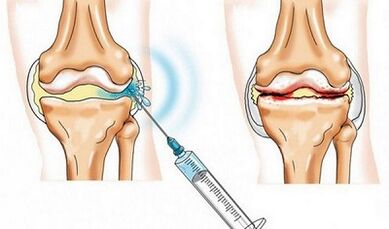
If you are not -Steroid anti -inflammatory drugs, you cannot block to relieve knee pain with arthrosis -a treatment method in which drugs are injected directly into the affected tissues to relieve pain and inflammation.In the therapy of arthrosis, the joint (injections in the joint cavity) and the periarticular (periarticular cavity) are used.
The main advantage of the method is an immediate targeted effect, as such an introduction is created in the inflammatory zone exactly in the inflammatory zone.In addition, drugs do not belong to the systemic bloodstream, which significantly reduces the risk of side effects.
In later stages of gonarthrosis, the joint gap narrows, the osteophytes grow and the joint surfaces are deformed, so only perirticular blockade is permitted.
The blockade of the knee joint can be performed using joint joint and corticosteroids.
Anesthesia is usually introduced in combination with steroid hormones to reduce the pain of the procedure.
Hyaluronic acid and chondroprotectors can also be directed directly into the joint.But in this case, we are not talking about the blockade, but about intraarticular injection, as these drugs do not block pain impulses, but trigger the processes of cartilage tissue regeneration.
Physiotherapy and manual therapy
The main methods of physiotherapeutic effects used in the treatment of arthrosis are as follows:
- laser treatment;
- ultrasound therapy;
- cryotherapy;
- Therapy with paraffin and ozokerite;
- Mud.
The main task of all physiotherapy procedures is to stimulate blood circulation in nearby tissues, to improve cartilage nutrition.
Practice therapy
Pain syndrome causes a patient with gonarthrosis to limit motor activity, resulting in atrophy of nearby ligaments and muscles.This disease negatively affects the joint tissues as the nutrients penetrate the synovial fluid into the cartilage during exercise.If the joint is constantly at rest, the dystrophic processes will worsen.
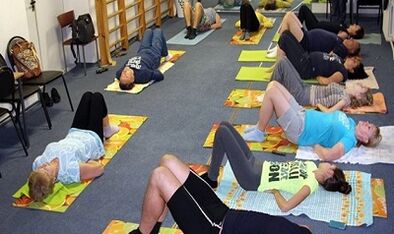
Therefore, physiotherapy exercises are an integral part of conservative therapy.Moderate physical activity allows you to strengthen your muscle device, improve your joint structures, eliminate stiffness and improve your knee motor function.
The therapeutic exercises are developed separately for all patients, taking into account the depth of lesion and the functional state of joint structures.
General recommendations to perform exercise therapy for arthrosis of the knee joint:
- Start classes only after stopping signs of acute inflammation;
- Do all the exercises smoothly without sudden movements;
- The load is gradually increasing;
- Remove heavy load on the joint (increased bending/extension of the knee);
- If pain or discomfort occurs, stop training.
Diet
With gonarthrosis, the following products:
- amino acids (dairy products, low fatty types of meat);
- collagen (food with gelatin);
- irreplaceable fatty acids (vegetable oils, fish);
- Sulfur and selenium (legumes, cereals, cabbage and apples, beef, chicken, eggs).
This is also important:
- Remove the use of smoked meats, pickles and marinades;
- limits salt consumption;
- Contact the five -time diet;
- Observe the drinking mode.
Excessive body weight is one of the main factors that provokes the formation of arthrosis of the knee joint.Therefore, the task of overweight patients is to reduce body weight.In this case, you can only achieve the result with a diet, as intensive sports are harmful to the inflamed joint.
To reduce body weight, it is recommended to exclude from the menu:
- fatty varieties of meat and fish;
- cream, homemade sour cream and other dairy products, which have a large percentage of fat content;
- margarine, mayonnaise, various sauces;
- confectionery;
- fast food;
- Sweet drinks.
Surgery

Arthrosis of the 3 knee joint is not used for conservative therapy, so surgery is the only way out for the patient.
There are two options for surgical intervention:
- Corrective osteotomy- is carried out in the early stages of the formation of Gonarthrosis, if the cartilage is partially destroyed, the osteophytes can be removed;
- Endoprostics- The replacement of the joint or its destroyed parts is carried out by complete destruction of the cartilage.
Forecast
Pathological changes in joint structures are progressive, irreversible.However, with early diagnosis and proper treatment, you can completely stop inflammation and stop the distrust of cartilage tissue - arthrosis of the 1st degree knee joint is well applied to conservative treatment.
Class 2 arthrosis, accompanied by cartilage destruction and the formation of osteophytes, conservative methods allow for slowing down or suspension of cartilage deformation, stopping inflammation and improving motor activity.However, doctors are often forced to block arthroscopy.
It is impossible to cure the arthrosis of the 3 degree knee joint in a conservative way.The only way to restore knee mobility is surgical intervention.

























